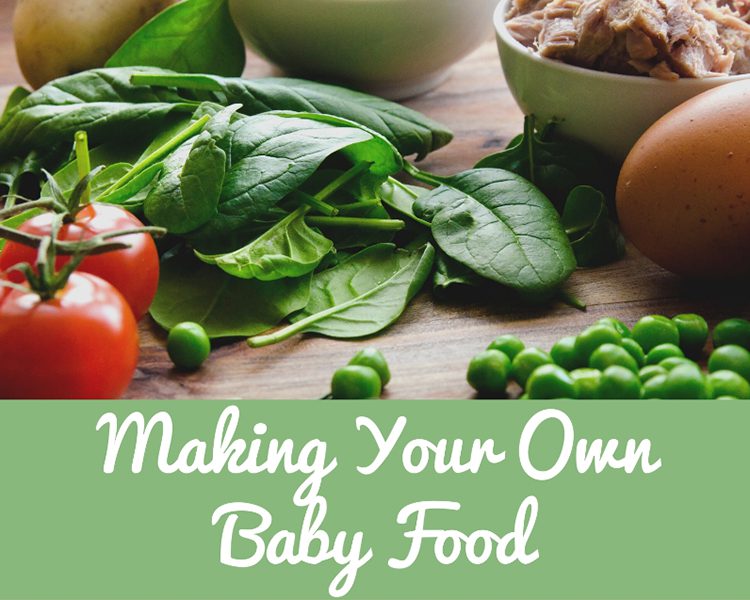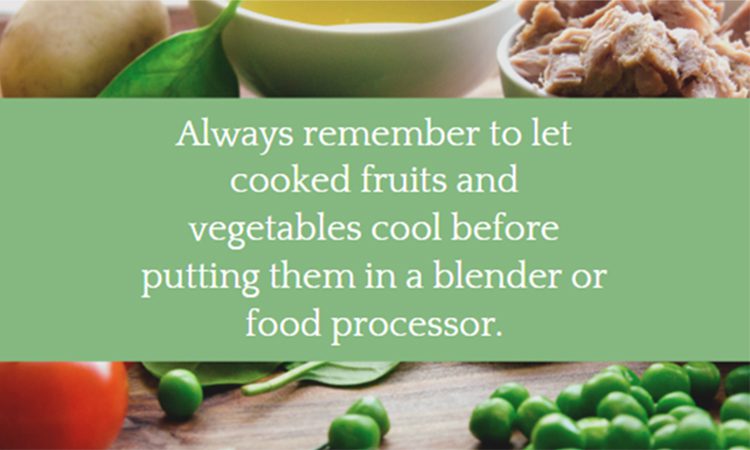Congratulations! You’ve made it through several months of feeding, snuggling, and bonding with your newborn baby. Now it’s time to celebrate another milestone – eating solid foods.

After about four to six months of breastmilk or formula, your baby will be ready to start trying other foods. There’s no limit to the kinds of baby foods available at your local grocery store, but making your own at home might be a cheaper, easier, and more healthy option. Making your baby’s food yourself has several benefits, including:
- Having fewer additives and preservatives
- Giving you control over how much sugar or salt goes into your baby’s food
- It’s more cost-effective than many store brands
- It gets your baby used to eating the same foods as the family.
All you really need to make your baby’s food is something to blend or mash it. There’s nothing wrong with using a regular, old-fashioned blender. Some foods, like bananas and avocados, can be mashed just as easily with a fork if you prefer to go low-tech.
Making Your Baby’s Food the Right Way
- For produce, give it a wash and then boil, bake or steam (depending on what it is) before blending or pureeing. Add the desired amount of liquid (water, formula, or breast milk) when pureeing. As your baby grows, less liquid will need to be added.
- For meat, puree cooked and skinned meats and serve either alone or with vegetables.
- For grains, cook normally then puree with liquid as needed.
- For seasoning, keep in mind that your baby hasn’t had added sugar or salt yet, so don’t rush into throwing them in. If your baby is going to be eating what is served to the rest of the family, take out her portion before seasoning the rest of the food for everyone else.
- For storage, pack your baby food into an air-tight container and refrigerate. Pureed foods can be kept in the refrigerator for four days or in the freezer for three months.
- Prepare and serve your baby’s food safely. Wash your hands and keep utensils and work surfaces clean.
- Stay away from dairy that’s “raw” — only use pasteurized!
You should also try to avoid canned foods, which tend to have high amounts of sodium. Use fresh or frozen!
When your baby is trying something for the first time, serve it to him without other foods to see how he reacts. This could help you learn about any potential allergies.
Homemade Baby Food Recipes
Mashed potatoes for Baby
- Peel and cut a small amount of potatoes.
- Put potatoes in a pan and fill with water. Boil the water, and then cook potatoes until tender.
- Drain potatoes.
- Put the potatoes back in the pan and mash until soft, adding the desired amount of liquid.
- Use this method rather than blending or pureeing in a food processor to keep the potatoes from getting a gummy consistency.
Applesauce for Baby
- Peel some apples and then remove the core and cut into small pieces.
- Add apples to a pan, cover with water, and bring to a boil. Let apples boil until they’re tender.
- Add the desired amount of liquid, then mash the apples while they’re still in the pot or remove them and blend them using a blender or food processor.
Mango Banana Puree for Baby
- Peel mango and chop it into small pieces.
- Remove banana peel and tear it into pieces.
- Add banana, mango, and a pinch of nutmeg to a blender or food processor with a splash of water.
- Blend until smooth.
Zucchini Potato Puree
- Peel and chop a couple of potatoes
- Boil them until they’re nearly soft.
- Peel your zucchini and cut into small slices.
- Add the zucchini to the pot then boil until the zucchini is soft.
- Put the boiled potatoes and zucchini into a blender or food processor and puree.
Always remember to allow cooked fruits and vegetables to cool before you put them in a food processor or blender.

Moms Share Their Best Tips for Making Baby’s Food at Home
“I used the Ninja Bullet. I steamed veggies, let them cool, and then blend. I wouldn’t have changed it for anything. You can use ice trays as one-ounce measurements and storage. I also used freezer-friendly storage containers.” –Erika Butler
“It’s honestly so easy. Just puree stuff and make sure you add water to keep it from being too thick. I love making my baby’s food myself.” –Heather Owens
“I try to limit the amount of plastic my kiddo’s food and drinks are exposed to. We loved storing homemade baby food in the small glass ball jars. They are freezer safe and easy to thaw and reheat.” –Lindsey Nichols
“I just used whatever blender I had at the time and steamed them and blended. Same with fruits — the apples I steamed a little also. You can add a drop of lemon juice to keep bananas and avocado from getting super brown. Since I stayed home with my daughter I just did it maybe once a day with whatever veggies we were all eating.” –Amber Springs
“I bought a Cuisinart mini-prep. I just added breast milk or formula to thin it out in the beginning. Then I froze it in ice cube trays until portions were big enough for mini bell jars. I used peas, butternut squash, avocado. I started with savory for a while before adding fruits.” –Nicole Vause
“I made all homemade with my first. I just squished ripe avocado and banana, overcooked sweet potatoes. It’s nice you don’t need any special equipment, just use a blender or hand masher.” –Audrey Waters


